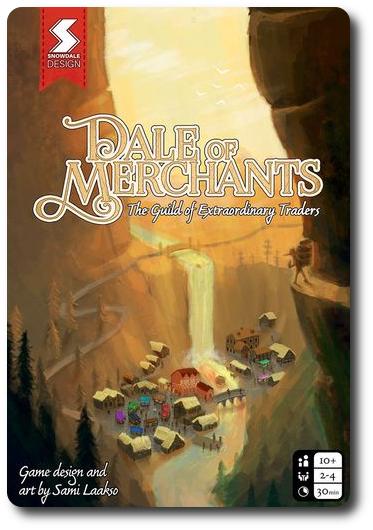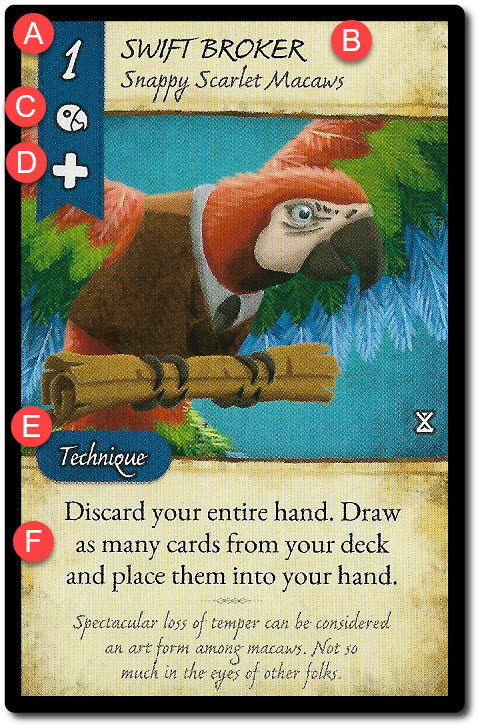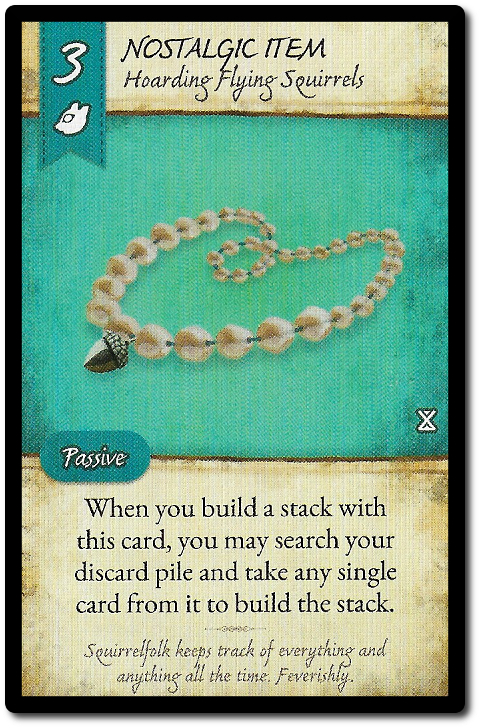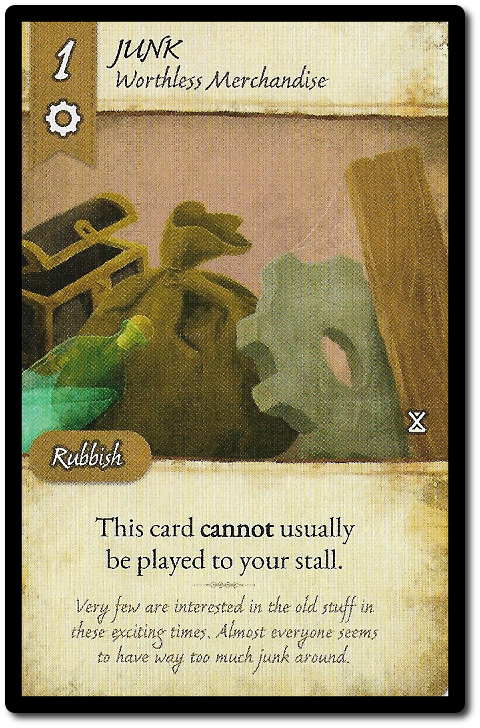
The Basics:
- For ages 10 and up
- For 2 to 4 players
- Approximately 30 minutes to complete
Geek Skills:
- Active Listening & Communication
- Counting & Math
- Logical & Critical Decision Making
- Reading
- Pattern/Color Matching
- Strategy & Tactics
- Hand/Resource Management
Learning Curve:
- Child – Moderate
- Adult – Easy
Theme & Narrative:
- Compete in the greatest merchant contest in the kingdom
Endorsements:
- Gamer Geek approved!
- Parent Geek approved!
- Child Geek approved!
American businessman and entrepreneur, James Cash Penney (yes, the guy who started J.C. Penney), said “There’s no better friend to any merchant than a fair competitor.” But in this game, it’s not about being fair. It’s about winning. That can be done through fair competition or through blatant underhanded disruption. All is fair in war and commerce.
Dale of Merchants, designed by Sami Laakso and published by Snowdale Design, is comprised of 90 Animalfolk cards (for a total of 6 decks of 15 cards each), 20 Junk cards, one Market board, and an Ocelot die (a custom six-sided die). The cards are as durable as your standard playing card. Sami Laakso also provided the illustrations, which are bright and colorful, further strengthening the game’s theme and narrative.
Building the Town of Dale
To set up the game, first create a deck for each player comprised of ten cards. Each player should have one Animalfolk card with a value of “one” and a number of Junk cards until the player’s deck is a total of ten cards. Shuffle the decks and place one next to each player, face-down. All remaining Junk cards should be placed in the middle of the playing area. This is the Junk draw deck for the duration of the game. Place the remaining value “one” Animalfolk cards not used back in the game box.
Second, shuffle the remaining Animalfolk cards and place the deck face-down in the middle of the playing area. This is the Market draw deck for the duration of the game.
Third, place the Market board next to the Market draw deck. Draw five cards from the Market draw deck and place them face-up on the Market board to create the Market.
Fourth, have each player draw five cards from their own decks to create their starting hand. Make sure there is room for each player to have their own discard pile and a row in front of them for cards to create their Stall (which is described in more detail below).
This completes the game set up. Determine who will go first and begin.
The Rules of Commerce
As Dale of Merchants is a card game, it’s important for the players to understand what each card represents and indicates if they hope to be competitive. Each of the card types in the game are summarized here.

A) Value of card (before any modifications from the Market or from other card effects)
B) Card name and set
C) Set icon
D) Indicates a bonus action can be taken if card is resolved
E) Card type (Technique, Passive, or Rubbish)
F) Effect description
Technique Cards
Technique cards provide a specific technique action. They change the standard rules of the game temporarily, giving the player an opportunity to bend the rules of commerce.

Passive Cards
Passive cards will apply their effect directly from the player’s hand or when the player uses the card for other actions.

Rubbish Cards
Rubbish cards are junk, but they still have a role to play. Junk cards and all things rubbish can be used to purchase new Animalfolk cards, replacing worthlessness with worthwhile cards of value.

Welcome to the Market!
Dale of Merchants is played in turns with no set number of turns per game. A player’s turn is broken down into two distinct phases which are summarized here.
Phase One: Take Action
The player can complete any of the following actions, but only one per turn by default. Some cards, once played, will give the player additional actions they can complete.
Market Action
The player purchases a card from the Market. The price of a card is indicated by the card’s value, both when buying and using them as currency. Any combination of cards from the player’s hand can be used to purchase the card. Cards used to purchase are placed in the player’s discard pile.
The location on the Market board will adjust the card’s default value. The right-most slot on the Market board does not adjust the card’s default value. However, every slot to the left increases the value by +1, as indicated by the Market board slot. Any purchased cards from the Market are added to the player’s hand.

Players can pay more for the Market card then what it is worth. The amount the player overpays must be smaller than the value of each card paid for. For example, if the player wanted to buy a card with the value of “five”, they could not overpay any more than “four” (which would mean they could pay no more than a total of “nine”).
Technique Action
The player plays one technique type card from their hand. Once played, the player follows the card’s instructions, completing the action described. The card is then discarded into the player’s discard pile after being resolved, unless the card states otherwise.
Some technique type cards will have a “+” icon, which indicates the player can take another action, but the player is only able to take this bonus action if they can successfully resolve the first technique action. Players do not get the bonus if the card is used to purchase another card. In this way, the player could play multiple cards in a row, with each card resolving its action first before a new card can come into play. Order of card play matters.
The technique the card provides is determined by the Animalfolk it represents:
* Macaws help with hand management
* Pandas help with managing the market
* Raccoons help by making a player’s opponents’ lives more difficult
* Squirrels help manage a player’s Stall
* Ocelots are shifty and will either provide a little luck or not (via the role of the Ocelot die)
* Chameleons allow players to mimic other cards in the game
Stall Action
The space in front of the player is reserved for a row of eight stacks of cards. This is the player’s Stall. The first stack the player creates must have a total value of no more or less than “one”. The next stack must have a value of no more and no less than “two”, and so on, with each stack created having a required value of one more than the previous stack.
Stacks are built by playing any number of Animalfolk cards of the same set face-up to the player’s Stall row. Stacks should be placed so the value of each card that is in the stack is visible. Stacks cannot be partially built. They must be completed at the time the cards are played to the Stall row.
The stack value is indicated by the values of the Animalfolks cards. Some cards will modify the values, meaning that a stack that should have no more and no less than a total value of “two” is suddenly worth “four”. Game wise, this is just fine (and desired). When making a new stack, the default value is always one more than the previous stack before any value adjustments.
Inventory Action
The player discards any number of cards from their current hand to their discard pile. These cards do not trigger any special effects or provide their value. They are simply ignored for now.
Phase Two: Clean-Up
The player now draws cards from their draw deck until their hand size is five cards. At any time the player’s deck is exhausted, meaning no more cards can be drawn from it by any player, the discard pile is shuffled and placed face-down to create the new draw deck. If a player is unable to create a new draw deck, they draw Junk cards.
The player then moves any cards on the Market board to an empty slot on the Market board’s right, decreasing its value. New Market cards are then drawn and placed to the Market board, starting with the right-most empty slot until the Market board has five cards. This means new cards that come into play will be higher priced. As the game continues, they will drop in price, but only if players actively purchase from the Market.
If the Market draw deck is exhausted, shuffle the Market discard pile to form a new Market draw deck. If there are no cards available in the discard pile, then nothing goes in the Market.
This completes the player’s turn. The next player in turn order sequence now takes their turn as noted above starting with phase one.
The Master of All Merchants
The game continues until a player completes their eighth Stall stack. The game comes to an immediate end and the player is declared the winner.
To learn more about Dale of Merchants, visit the game’s web page.
Final Word
 The Child Geeks loved the art and were able to quickly grasp the game’s goal. What slowed them down was learning the cards. According to one Child Geek, “The game is easy, but I don’t think you can play very well unless you know all the cards.” Which is to say, the Child Geeks spent the first couple of games learning how the cards interacted and what cards were available. Once they were familiar with the game, their enjoyment increased. As one Child Geek put it, “You can only really play this game well if you know what all your animal friends can do for you.” There are not a lot of cards in the game to learn, but there are a good number of combos and timing in the game is pretty important. As such, the game’s learning curve was found to be moderate, but not at all difficult. When the last goods were sold and the shops closed, the Child Geeks voted to approve Dale of Merchants.
The Child Geeks loved the art and were able to quickly grasp the game’s goal. What slowed them down was learning the cards. According to one Child Geek, “The game is easy, but I don’t think you can play very well unless you know all the cards.” Which is to say, the Child Geeks spent the first couple of games learning how the cards interacted and what cards were available. Once they were familiar with the game, their enjoyment increased. As one Child Geek put it, “You can only really play this game well if you know what all your animal friends can do for you.” There are not a lot of cards in the game to learn, but there are a good number of combos and timing in the game is pretty important. As such, the game’s learning curve was found to be moderate, but not at all difficult. When the last goods were sold and the shops closed, the Child Geeks voted to approve Dale of Merchants.
 The Parent Geeks found the game to be a perfect match for the games they wanted to play in the limited available free time they had. According to one Parent Geek, “I like playing games, but seldom have the time to play a game that really interests me. This game can be played in less than an hour and made me think. I really liked that.” Another Parent Geek said, “This game feels like just another deck builder to me, but because it is small and self-contained, it also feels very complete and well designed.” The Parent Geeks found Dale of Merchants worked very well with their peers and also with their families. Admittedly, they enjoyed it more with their peers, however, as they felt they could get really nasty with each other while playing. As one Parent Geek put it, “I have no problem making the competition work hard for the win.” Dale of Merchants was approved by the Parent Geeks.
The Parent Geeks found the game to be a perfect match for the games they wanted to play in the limited available free time they had. According to one Parent Geek, “I like playing games, but seldom have the time to play a game that really interests me. This game can be played in less than an hour and made me think. I really liked that.” Another Parent Geek said, “This game feels like just another deck builder to me, but because it is small and self-contained, it also feels very complete and well designed.” The Parent Geeks found Dale of Merchants worked very well with their peers and also with their families. Admittedly, they enjoyed it more with their peers, however, as they felt they could get really nasty with each other while playing. As one Parent Geek put it, “I have no problem making the competition work hard for the win.” Dale of Merchants was approved by the Parent Geeks.
 The Gamer Geeks found Dale of Merchants to be “yet another deck building game”. Which is not a bad thing, mind you, but nor was it particularly exciting for this group of gaming elitists who play many, many games. What they did appreciate was how well the game was designed. According to one Gamer Geek, “The game is solid. The rules are simple, but the card interaction creates a deeper game play than I expected.” Deep, yes, but not overly so. The Gamer Geeks found that Dale of Merchants was just deep enough to keep them engaged, but there was only so much depth to plunge into. One Gamer Geek said, “You play this game a few times and you’ve seen pretty much all the combos and possibilities.” True, for those who keep track of such things, but that didn’t stop the Gamer Geeks from all agreeing that Dale of Merchants would be welcome at their gaming table as a game filler.
The Gamer Geeks found Dale of Merchants to be “yet another deck building game”. Which is not a bad thing, mind you, but nor was it particularly exciting for this group of gaming elitists who play many, many games. What they did appreciate was how well the game was designed. According to one Gamer Geek, “The game is solid. The rules are simple, but the card interaction creates a deeper game play than I expected.” Deep, yes, but not overly so. The Gamer Geeks found that Dale of Merchants was just deep enough to keep them engaged, but there was only so much depth to plunge into. One Gamer Geek said, “You play this game a few times and you’ve seen pretty much all the combos and possibilities.” True, for those who keep track of such things, but that didn’t stop the Gamer Geeks from all agreeing that Dale of Merchants would be welcome at their gaming table as a game filler.
 Like all deck building games, one cannot truly understand the game’s full potential until it’s played multiple times. After playing the game just once, I recognized that there were many more card combos to be had than just the few I was able to play or see. But the “building” part of the game is somewhat trumped by the very real need to build a deck quickly with the singular purpose to build stacks in the player’s Stall row. Luckily, the combos to be had and card interactions are straight forward, meaning players won’t have to spend a lot of time thinking too hard or too long about what cards to purchase and to play.
Like all deck building games, one cannot truly understand the game’s full potential until it’s played multiple times. After playing the game just once, I recognized that there were many more card combos to be had than just the few I was able to play or see. But the “building” part of the game is somewhat trumped by the very real need to build a deck quickly with the singular purpose to build stacks in the player’s Stall row. Luckily, the combos to be had and card interactions are straight forward, meaning players won’t have to spend a lot of time thinking too hard or too long about what cards to purchase and to play.
Which is not to say this is an easy game. Far from it. Each turn is important and players do not want to get behind. The first couple of stacks are easy and give the player a false sense of momentum. Once you hit stack four, players will quickly see where their decks need improvement. Better yet, when players build their stacks, they lose a part of their engine (what I call the deck the players are building). Each tweak to a player’s deck is focused on building the next stack, but you have to remove those cards from your deck when you play a stack. This means players have to think both long and short-term. It creates for some very interesting and creative ideas on how best to manage cards and deck builds.
Throw in the Market and the adjustable card values and you have a game that is constantly shifting the ground the players are standing on. While this might be perceived as chaotic, other players and myself simply found it to be one more thing to manage. A player must utilize their skills to form a strategy and be flexible enough adjust their tactics according to changes in the game that happen often. Especially when you throw in the ability to mess with opponents. A few of our players found this element of game play to be disruptive, but the intent was never in question. Since there is a race element to the game, the game designer (and rightfully so) threw in a mechanism that allows players who are getting behind to slow down the competition. Never stop them, mind you. The game gives players the ability to toss road blocks, not the ability to destroy said road to victory.
In the end, Dale of Merchants is a small and streamlined deck building game. Great as a game filler and as the game for the evening. Do give it a try, especially if you are not familiar with deck building games.
This game was given to Father Geek as a review copy. Father Geek was not paid, bribed, wined, dined, or threatened in vain hopes of influencing this review. Such is the statuesque and legendary integrity of Father Geek.




Pingback: Dale of Merchants 2: The Era of Trade Masters Game Review - Father Geek
Pingback: Dale of Merchants Collection Game Review - Father Geek
Pingback: Dale of Merchants 3: The Grand Continental Railway Game Review - Father Geek